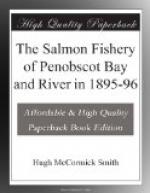(3) The remarkable run in May and June, 1896, of fish of comparatively small size that had apparently just reached maturity and the relative scarcity of large fish that had evidently been in the river during one or two previous seasons seemed to show a tendency toward the depletion of the run of old fish and the substitution of a run of young, artificially hatched fish.
(4) A feature of the salmon supply in recent years, on which the fishermen nearly all lay considerable stress, is that the runs in April and July, which in former years were often quite important and remunerative, have of late been very poor, although the fish constituting them are of large size, while the runs in May and June have kept up, but have consisted chiefly of comparatively small fish. In this the fishermen believe they see evidence of the work of the hatchery, for the young salmon artificially hatched have been from eggs of May and June fish, and the fishermen think that such young fish, when they return to the river to spawn, will come at about the same time that their parents did.
Many salmon fishermen might be quoted on the question of results of propagation. A few sample statements and records of salmon taken will be given covering different parts of the bay and river.
Mr. Francis French, an experienced salmon fisherman of Stockton, on the western side of Penobscot Bay, reports that of the 61 salmon taken in his weir in 1896, 56 were under 11 pounds in weight, and all evidently belonged to the same year’s brood. In 1895 the 29 salmon obtained by Mr. French averaged 20 pounds each. According to his observations, a very large percentage of the salmon in the Penobscot region in 1896 were hatchery fish that then entered the river for the first time.
Mr. A. H. Whitmore, a salmon fisherman of over thirty years’ experience, who fishes three weirs off the southern end of Whitmore Island, states that in that part of the river the catch in 1896 was the largest in thirty years, with the exception of one season. He thinks there is no doubt whatever of the beneficial results of artificial propagation, as shown by the maintenance of the supply when obstructions to the passage of salmon to the upper waters must greatly curtail natural spawning.
Mr. Joseph Hurd, of Winterport, has two weirs at Oak Point, which is the upper limit of weir fishing for salmon on the west side of the river; the nets are about 12 miles below Bangor; 25 salmon were taken in 1895, and 60 in the following year. The catch was better in 1896 than in a number of years. Eight years before, Mr. Hurd took 140 salmon, which was the best season in his experience; since then the fish have been decreasing until 1896. He thinks very few fish get to their spawning-grounds, owing to dams and other obstructions in the river above Bangor, and has no doubt the small fish which were so conspicuous in 1896 were from the Government hatchery.
Mr. William F. Abbott, of Verona, who has two weirs on Whitmore Island, caught 41 salmon in 1895, and 80 in 1896. He makes the following statement:




